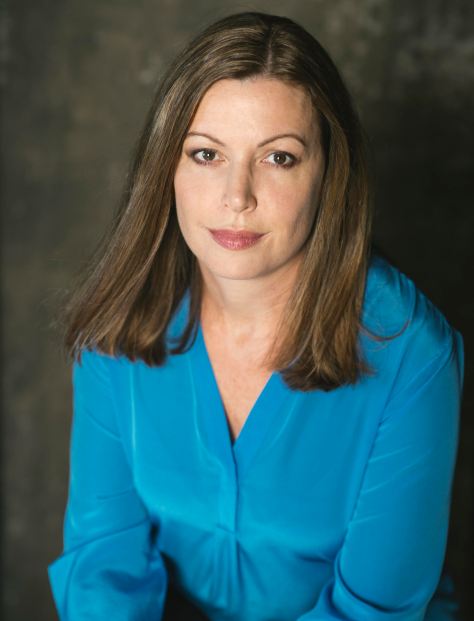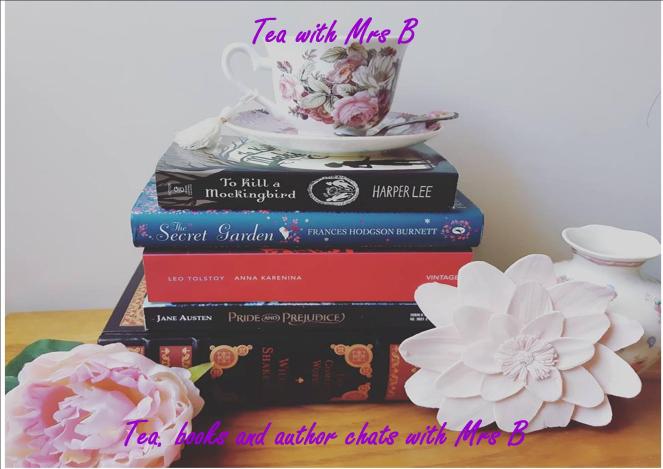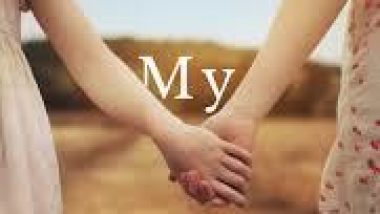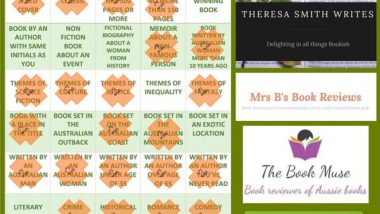
Welcome to Tea with Mrs B, an author interview series. Here to share a pot of tea and to chat about her brand new book, The Orange Grove, is Kate Murdoch.

Kate Murdoch is the author of Stone Circle. She exhibited widely as a painter both in Australia and internationally before turning her hand to writing.
Her short-form fiction has been published in various literary journals in Australia, UK, US and Canada.
Stone Circle is a historical fantasy novel set in Renaissance Italy. It was released by Fireship Press December 1st 2017. Stone Circle was a First in Category winner in the Chaucer Awards 2018 for pre-1750’s historical fiction.
Kate was awarded a KSP Fellowship at the KSP Writers’ Centre in 2019 to develop her third novel, The Glasshouse.
Her novel, The Orange Grove, about the passions and intrigues of court mistresses in 18th century France, will be published by Regal House Publishing in 2019.
Hello Kate. It is my pleasure to warmly welcome you to my blog, Mrs B’s Book Reviews. Thank you for joining me for Tea with Mrs B, an author interview series. To set the mood for our tea infused interview, what is your preferred beverage, tea, coffee or other? And side accompaniment, scone, cake or other?
Thank you for having me. I’d love a latte and a vanilla macaron, please.
Can you tell us what genres you write for and how many books you have had published?
I write historical fiction and have had two books published, Stone Circle (2017) and The Orange Grove (2019.)
The Orange Grove is your latest release, can you describe it in just a sentence?
A mistress in 18th century France is forced to choose between position and morality.
Why did you choose the title, The Orange Grove for your second novel?
It’s an integral location in the novel. There is an orange grove in the story, in the grounds of the Château d’Amboise. There’s a lot in the narrative that takes place there—it’s somewhere where the children play, the adults take walks and there’s a scene where the orange grove conceals a crucial act. It bears witness to the drama unfolding and it marks the passage of time through the ripening of fruit, the trees flowering etc. It was always the title, there was never any question in my mind.
How long did it take you to write The Orange Grove?
It took two years, but the research started months before the writing itself.
How different was the experience of writing The Orange Grove, compared to your debut novel, Stone Circle?
It was different on a number of levels. When I wrote Stone Circle, I was still finding my voice and at an earlier stage of learning my craft, so it took more drafts and feedback from many sources before it was ready to submit. I don’t think as a writer you ever stop learning, with each novel you discover something, whether it’s a way of building tension, or developing characters who are more layered. So, whilst Stone Circle was more about the narrative, in The Orange Grove I knew I wanted the interpersonal conflict and tension to be paramount, along with the theme of morality. Then it was a delicate balance to work these two elements together. It was more complex in this respect, more of a challenge. Yet Stone Circle required an enormous amount of research into alchemy and Renaissance life which I had to integrate in a way that read smoothly and didn’t announce itself to the reader.
Why did you choose to base your second novel in France in the 1700’s?
I had a fascination with the period of Louis XIV’s rule—the opulence that characterised his court and the lives of nobles during this time. I was interested in how extreme wealth might corrupt people, what they would do to obtain and keep it. The desire for status and position was an obsession for the nobility, they were in many cases ruthless in their striving. This competitive environment, where no one would catch you if you fell, was irresistible from a storytelling point of view. I wanted to see how love and friendship formed within these conditions, and how this increased pressure might bring out the worst in my characters.
Can you tell us about the research process to bring The Orange Grove to life? How did you incorporate this research into the narrative?
I drew from a number of sources: diaries from the time were incredibly helpful in terms of the social and cultural mores. I read the diaries of Madame de Sévigné, Louis XIV, and Elisabeth Charlotte Madame Palatine who was the wife of the Duc d’Orléans. There was a wonderful book by Antonia Fraser about Louis XIV’s mistresses and fiction books set in the period. I watched movies, looked at portraits of nobles of the time and reconstructed interiors at the Louvre. Many years earlier I had visited Versailles, and still had the visual memories. I also taught myself to read tarot cards to give authenticity to the tarot reading scenes. The diaries helped with the voice of my characters along with their preoccupations—religion was very important to many people at the time, so I made some of my characters more pious. In terms of how the research was incorporated, for me, research is a bit like placing material my brain which I know will emerge as atmosphere and visuals. Sort of like brewing tea. It needs to sit there for a while and swirl around, gain momentum. I keep researching as I write, especially when I get stuck, and it enriches the writing without me having to consciously ‘place’ it in the text.
Can you tell us more about the main themes of your novel?
The main theme is how morality is not often black and white and that peoples’ past trauma and present circumstances can cause them to act negatively. They find a way to justify their behaviour and it’s rarely coming from a place of pure malice. I wanted to look at negative acts through a lens of compassion and understanding. To consider benevolence and cruelty as being on a spectrum of morality that makes us human, a mixture of both these extremes. People are often somewhere in the middle. My protagonist, Henriette, is attached to her ideals, but through love she is more able to empathize with imperfection. Secrets are central to the story as well, how they can be shameful or sad and the burden of holding them. This theme ties in with the effects of loss, planned or accidental. Alongside all of this there is love as a driving force, the universal desire for it and how its absence can push people to extremes.
Where did the inspiration for your characters come from?
My characters tend to be a mixture of people I’ve met, but often come to life without resembling anyone I know. It’s a mysterious process, and I have to allow each character to emerge on the page. They do this through ‘telling’ me what they will be doing next. This makes me sound a little crazy, but it’s often how it happens. For instance, once I was writing a scene where my protagonist was meant to be having a blossoming romance with another character. Halfway through the scene it became clear that she was also interested in someone else. The whole trajectory of the story changed.
What ingredients do you feel are necessary to compose a successful historical fiction narrative?
The most important element is research because it enables an authentic sense of place and the cultural sensibilities of the time. Added to this, a strong plot, crackling narrative tension and layered characterisation. Finally, themes that tie it all together.
What do you hope readers will take away from reading The Orange Grove?
A sense of hope—that through struggle and error people can be redeemed and grow. Empathy and compassion for the flaws of others.
How did you make the transition from an internationally recognised painter to a published author?
It was very gradual. I had been an artist-in-residence at a gallery when it closed down and was in the process of looking for another gallery when I began to write a manuscript. By the time the manuscript (a supernatural thriller that never saw the light of day) was finished, I was hooked on writing and it was like being swept up in a cyclone. I became more immersed in learning how to write and meeting others who shared the same passion. I never emerged and it has taken over my life. In a practical sense, I attended courses, joined a writing group, and was on a site called Authonomy, run by Harper Collins, where I exchanged critiques with other writers at different levels of experience. This was the most rapid growth period for me as a writer because many people offered me feedback for my manuscript on Authonomy, and I learnt a lot by reading others’ work. I’m still in touch with a number of writers from this site, who are located around the world. During this time, I studied Professional Writing and Editing at Swinburne, which was a crucial step in my development and learning of craft. After a while, my short stories began to be published and I found my agent. Around a year later, Stone Circle was picked up. My painting studio is a very neglected place these days, which is sad, but I’m having so much fun with the direction I’ve taken.
Can you tell us about your creative working space, where do you write and is there anything vital you need to get started?
I’m not very good at staying put at a desk, so am either on a sofa or armchair with a portable desk, or at the dining table. I like to be able to look outside as I work, and the office at home is dark and without a view. A scented candle and coffee, or copious amounts of herbal tea usually make the words flow.
Is there a genre you haven’t tried writing yet, but want to in the future?
I love writing historical fiction and taking myself to unfamiliar places, so am likely to stay in this genre.
What is the best part of being a published author?
The people and writing community. I’ve been fortunate to meet other authors who understand both the joys and agonies of the writing life and who support me. We talk about the challenges and workshop each other’s work. They understand when I go quiet because it’s so all consuming. I’m incredibly grateful to them and also inspired—they’re tender but determined. This combination of gentleness and strength is something I’ve noticed in other authors. They’ve had to push themselves, but also have sensitivity that informs their writing.
Having books in the world is also a privilege because you’re making a connection with people you will never meet, sharing your deepest thoughts and ideas about life. In some cases, you’re able to have a conversation with readers, which is so satisfying and thrilling.
Aside from writing, do you have any interesting hobbies?
Travel has always been important to me, being in other places re-energises me and stimulates my creativity. I love hiking in the country, keeping fit and balanced through pilates and yoga, reading as much as I can. Lunching with close friends is always a joy, and I’m a passionate photographer. I also practise my French with a tutor from time to time.
If you could slip back in time, what era would you travel to and why?
The 1930’s. Going to parties in Paris would be my ideal. It was a very stylish era, the fashion and architecture were sublime. The world was more innocent prior to the horrors of World War Two. Socially and culturally, especially in Europe, there was a lot going on. I would be intrigued by the visual details and the people.
What is next on the horizon for Kate Murdoch? Do you have any writing projects you would like to share with us?
I recently returned from a research trip to Sicily for a manuscript I’m in the process of editing, The Glasshouse. It’s set in 1920, and is about a girl orphaned by the 1908 earthquake in Messina who is adopted by a wealthy Palermo family. I’m working on the second draft, and was so lucky to be able to see many of the locations in the story firsthand. This experience has verified what I’ve written, but also given me ideas of elements to add.
I’m also working on the first draft of dual-timeline story set in wartime Croatia and 1960’s Melbourne.
What 2019 book releases are you most excited to read?
I’m looking forward to reading The Heart of the Ritz by Luke Devenish and Three Women by Lisa Taddeo.
Finally, wrapping up our tea themed interview, who would you most like to share a pot of tea with?
Elizabeth Gilbert to listen to her insight and humour, to be enveloped in her warmth. I think she’s a wonderful writer, an inspiring human who brings a lot of light to people.
Thank you for taking the time to visit Mrs B’s Book Reviews for Tea with Mrs B Kate. Congratulations on the publication of The Orange Grove!
When status is survival, every choice has its consequence.
Blois, 1705. The chateau of Duc Hugo d’Amboise simmers with rivalry and intrigue.
Henriette d’Augustin, one of five mistresses of the duc, lives at the chateau with her daughter. When the duc’s wife, Duchesse Charlotte, maliciously undermines a new mistress, Letitia, Henriette is forced to choose between position and morality. She fights to maintain her status whilst targeted by the duchesse who will do anything to harm her enemies.
The arrival of charismatic tarot reader, Romain de Villiers, further escalates tensions as rivals in domestic politics and love strive for supremacy.
In a society where status is a matter of life and death, Henriette must stay true to herself, her daughter, and her heart, all the while hiding a painful secret of her own.
Purchase Links:
REGAL HOUSE PUBLISHING | BOOKTOPIA | ANGUS & ROBERTSON | BOOMERANG BOOKS | READINGS | KOBO | BARNES & NOBLE | BOOK DEPOSITORY | AMAZON
 Connect with Kate here:
Connect with Kate here:
Website
Blog
Goodreads


